
Guadalajara is a metropolis in western Mexico and the capital of the state of Jalisco. According to the 2020 census, the city has a population of 1,385,629 people, while the Guadalajara metropolitan area has a population of 5,268,642 people, making it the third-largest metropolitan area in the country and the twentieth largest metropolitan area in the Americas Guadalajara has the second-highest population density in Mexico, with over 10,361 people per square kilometer. Within Mexico, Guadalajara is a center of business, arts and culture, technology and tourism; as well as the economic center of the Bajío region. It usually ranks among the 100 most productive and globally competitive cities in the world. It is home to numerous landmarks, including Guadalajara Cathedral, the Teatro Degollado, the Templo Expiatorio, the UNESCO World Heritage site Hospicio Cabañas, and the San Juan de Dios Market—the largest indoor market in Latin America.

San Luis Potosí, commonly called SLP or simply San Luis, is the capital and the most populous city of the Mexican state of San Luis Potosí. It is the municipal seat of the surrounding municipality of San Luis Potosí. The city lies at an elevation of 1,864 metres. It has an estimated population of 824,229 in the city proper and a population of approximately 1,221,526 in its metropolitan area, formed with the neighbour city of Soledad de Graciano Sánchez and other surrounding municipalities, which makes the metropolitan area of Greater San Luis Potosí the eleventh largest in Mexico.
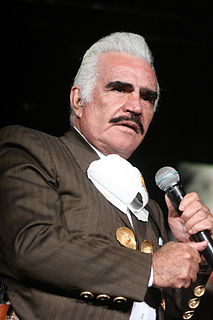
Vicente Fernández Gómez was a Mexican singer, songwriter, actor, and film producer. Nicknamed "Chente", "El Charro de Huentitán", "El Ídolo de México", and "El Rey de la Música Ranchera", Fernández started his career as a busker, and went on to become a cultural icon, having recorded more than 100 albums and contributing to more than 30 films. His repertoire consisted of rancheras and other Mexican classics.

Zapopan is a city and municipality located in the Mexican state of Jalisco. Part of the Guadalajara Metropolitan Area, the population of Zapopan city proper makes it the second largest city in the state, very close behind the population of Guadalajara proper. It is best known as being the home of the Virgin of Zapopan, an image of the Virgin Mary which was made in the 16th century. This image has been credited with a number of miracles and has been recognized by popes and even visited by Pope John Paul II. The municipality is also the home of the Centro Cultural Universitario, which contains one of the most important concert venues in Latin America and is the home of the new stadium for the C.D. Guadalajara.
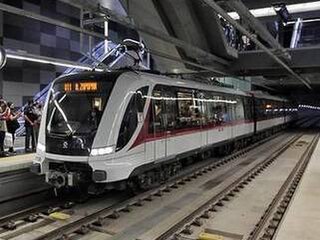
The Sistema de Tren Eléctrico Urbano, is an urban rail transit system serving the Guadalajara metropolitan area, in the municipalities of Guadalajara, Zapopan and Tlaquepaque, in the state of Jalisco, Mexico. It is owned by the state of Jalisco, and is operated by the state authority SITEUR. Opened in 1989, the system consists of three lines: Line 1, running from north to south with 20 stations; Line 2, running from the city center to the east with 10 stations; and Line 3, running from the north-west to south-east with 18 stations. A fourth line is under construction, which will run from the city center to the south of the metropolitan area.
The Plaza de toros Nuevo Progreso is a bullring in the Mexican city of Guadalajara, Jalisco. It is currently used for bull fighting and also for hosting musical events, and professional wrestling events. The bullring holds 16,561 people and was built in 1966 to 1967.

The Jalisco New Generation Cartel or CJNG, formerly known as Los Mata Zetas, is a semi-militarized Mexican criminal group based in Jalisco which is headed by Nemesio Oseguera Cervantes, one of the world's most-wanted drug lords. The cartel has been characterized by its aggressive use of extreme violence and its public relations campaigns. Although the CJNG is particularly known for diversifying into various types of criminal rackets, drug trafficking as well as stealing crude oil remain among their most profitable criminal activities. The cartel has also been noted for cannibalizing some of its victims, sometimes during the training of new sicarios or cartel members as well as using drones to attack their enemies. U.S. prosecutors have said operatives of the cartel tried to buy belt-fed M-60 machine guns in the United States, and once brought down a Mexican military helicopter with a rocket-propelled grenade.
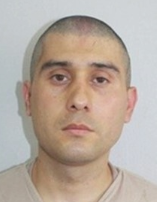
Érick Valencia Salazar, commonly referred to by his alias El 85, is a Mexican suspected drug lord and high ranking leader in the Nueva Plaza Cartel. He previously served as a high-ranking leader of the Jalisco New Generation Cartel (CJNG), a criminal group based in Jalisco. The Mexican Army suspects he was responsible for supervising the CJNG's cocaine and ephedrine delivery shipments from Colombia and China to Mexico, and for coordinating attacks against rival groups like La Resistencia and Los Zetas in the 2010s. Before leading the CJNG, Valencia reportedly held a leadership role within the Milenio Cartel, the predecessor group where the CJNG originated from. When several of his superiors were arrested and/or killed, Valencia and several others from the Milenio Cartel reportedly formed the CJNG.

Martín Arzola Ortega, commonly referred to by his alias "El 53", was a Mexican convicted drug lord and former high-ranking leader of the Jalisco New Generation Cartel (CJNG), a criminal group based in Jalisco. He worked under Nemesio Oseguera Cervantes, the alleged top leader of the CJNG. Arzola Ortega began his criminal career in 1998 as a cargo truck thief and eventually joined the Milenio Cartel, the predecessor group of the CJNG. After several of his bosses were arrested and/or killed, he founded the CJNG with other defectors in the 2010s.

A statue of Miguel Hidalgo y Costilla is installed in front of the Legislative Palace of Guadalajara, in the Mexican state of Jalisco. Hidalgo y Costilla is depicted enraged, breaking chains of slavery and urging for freedom. The bronze statue is 4 meters (13 ft) tall and was designed by Ignacio Díaz Morales. It was unveiled in 1952 along with the Plaza de la Liberación.

The Monumento a la Madre is installed in Guadalajara, in the Mexican state of Jalisco. It features an indigenous woman looking at the sky while she covers her child. It is a bronze statue that lies on a volcanic rock base. It lies along Plaza 10 de Mayo and it was inaugurated in 1956.

The Fuente de los Niños Traviesos, colloquially known as the Fuente de los Niños Miones, is a fountain with sculptures of boys in Guadalajara, in the Mexican state of Jalisco.

Plaza de Armas is an urban square in Centro, Guadalajara, in the Mexican state of Jalisco.

Plaza de la Liberación is an urban square in Centro, Guadalajara, in the Mexican state of Jalisco.

Zona Centro is the historic center of Guadalajara, in the Mexican state of Jalisco.
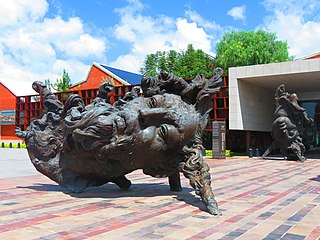
Cabeza Vainilla is one of three sculptures by Javier Marín. The statues are commonly installed in museums and squares. The whole set features giant heads. As of 2021, Cabeza Vainilla is installed in Zapopan's Plaza de las Américas Juan Pablo II, in the Mexican state of Jalisco.

Plaza Tapatía is an urban plaza in Centro, Guadalajara, in the Mexican state of Jalisco.

Inmolación de Quetzalcóatl is a fountain and sculpture by Victor Manuel Contreras, installed in Plaza Tapatía, in Centro, Guadalajara, in the Mexican state of Jalisco.

An antimonumenta was installed in the Plaza de Armas, in Guadalajara, Jalisco on 25 November 2020, the date commemorating the International Day for the Elimination of Violence against Women, during the annual march of women protesting against gender violence. The sculpture is symbolically named Antimonumenta and it was inspired by the anti-monument of the same name placed in Mexico City a year prior.
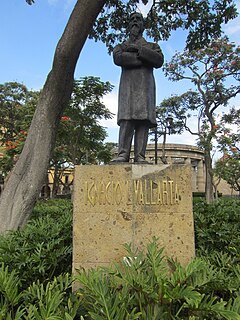
A statue of Ignacio Vallarta is installed along the Rotonda de los Jaliscienses Ilustres, in Centro, Guadalajara, in the Mexican state of Jalisco.




















